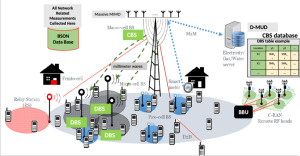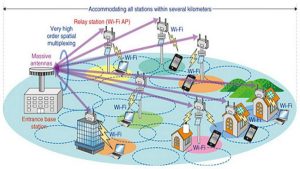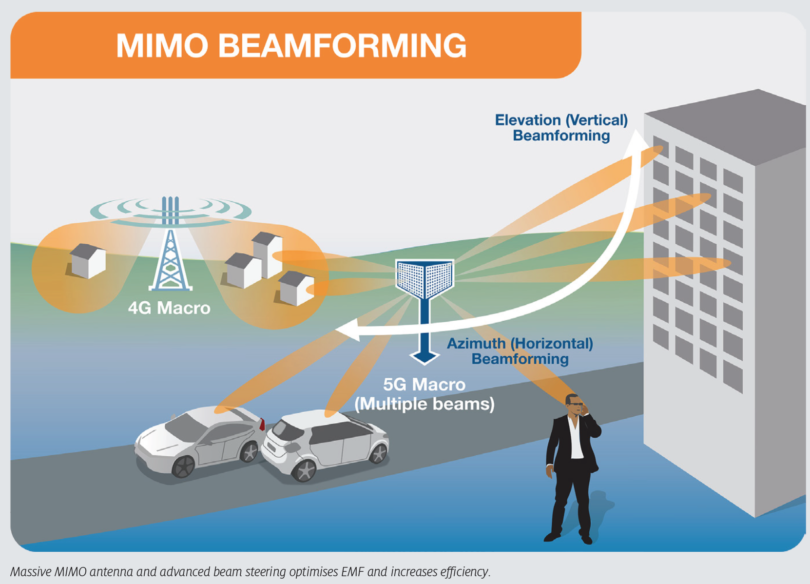It’s no secret that modern wireless communication systems rely heavily on beamforming technology, especially those operating within massive MIMO networks. With the ever-increasing demand for high-speed data transmission and low-latency applications, this technique has become more vital than ever before. Of course, with 5G network technology now in full swing, it goes without saying that beamforming is a critical component of MIMO systems.

Enter massive MIMO – a revolutionary approach to antenna design that incorporates hundreds or even thousands of antennas to improve spectral efficiency and increase capacity. However, none of this would be possible without the crucial role played by beamforming in enabling multiple users to share the same frequency band simultaneously without interference. By focusing signals towards designated users while minimizing disruptions from other sources, beamforming can significantly enhance the performance of massive MIMO networks.
Digital beamforming and analog-digital hybrid beamforming are two prominent types of techniques used in these systems. While digital relies on advanced signal processing algorithms to adjust phase and amplitude settings for each individual antenna element independently, analog-digital hybrid combines elements of both digital signal processing with traditional components like phase shifters or attenuators for optimal power efficiency alongside acceptable levels of overall system performance. As research continues into developing new precoding techniques designed specifically for use with these advanced technologies further optimization will undoubtedly follow regarding energy consumption as well as increased spectral efficiency within massive MIMO networks themselves!
Enabling Technologies for Massive MIMO in Networks
Contents
- 1 Enabling Technologies for Massive MIMO in Networks
- 2 Beamforming Techniques for Massive MIMO Systems
- 3 Hybrid Analog-Digital Beamforming for Large-Scale Antenna Systems
- 4 Precoding Techniques for Spectral and Energy Efficiency in MIMO Systems
- 5 Mitigating Pilot Contamination Effect in MIMO Networks
- 6 Future Research Directions in Beamforming for MIMO Communication
- 7 Role of Beamforming in Networks and its Significance in Wireless Communication Systems
The development of massive MIMO systems has been greatly influenced by smart antenna technology and its implementation of beamforming. These antennas possess an incredible ability to adjust to fluctuations in signal conditions, enabling them to concentrate their energy towards specific individuals or groups. As a result, the adoption of beamforming antennas has become a catalyst for 5G networks due to the improvements they offer in spectral efficiency and network capacity.

Hybrid beamforming technology is being hailed as a promising solution for large-scale antenna systems that are inundated with too many antennas for full digital beamforming. By merging analog and digital techniques, hybrid beamforming can reduce complexity and power consumption while maintaining performance levels comparable to fully-digital solutions. Experts predict that hybrid beamforming will play an essential role within high mobility scenarios with dynamic channel conditions.
Moreover, precoding techniques have garnered significant interest as an effective means of maximizing spectral and energy efficiency in MIMO systems. Through transmit signal optimization based on knowledge of channel state information (CSI), precoding can minimize interference between multiple users thereby enhancing overall system performance. Given these advantages, it is expected that research into precoding will continue playing a pivotal role within the context of massive MIMO communication systems moving forward.\n
Beamforming Techniques for Massive MIMO Systems
Enter Massive MIMO technology – an innovation that aims to enhance the performance of MIMO communication systems. This technology employs a colossal amount of antennas, allowing for more exceptional spectral and energy efficiency compared to traditional multi-antenna systems. However, unlocking the full potential of massive MIMO requires beamforming techniques.
One such technique is analog beamforming, where signals are modified in terms of phase and amplitude at each antenna element in an array to create directional beams towards specific users or groups thereof. Unlike digital beamforming which demands complex signal processing algorithms, analog beamforming provides substantial improvements in wireless communication while remaining relatively uncomplicated.
Smart antennas further augment the effectiveness of beamforming techniques within massive MIMO systems by dynamically adjusting their radiation pattern according to user feedback and environmental conditions. These antennas enable efficient utilization of radio frequency (RF) resources by directing energy towards desired users while minimizing interference with other users. The result? Spectral and energy efficiency heightened manifold without requiring additional bandwidth or power allocation – impressive!
Hybrid Analog-Digital Beamforming for Large-Scale Antenna Systems
The perplexing and bursty technique known as Hybrid Analog-Digital Beamforming is a marvel of modern engineering in large-scale antenna systems. This mind-boggling technology has been developed to tackle the arduous task of mmWave Massive MIMO, which craves high data rates within a confined frequency band. By combining analog and digital precoding schemes, this hybrid approach enables superior radiation pattern control while transmitting data to numerous users.
Thanks to its employment of linear precoding techniques, maximum ratio transmission (MRT) for each user can be achieved, resulting in higher spectral efficiency. The use of Hybrid Analog-Digital Beamforming also allows for better energy usage through reducing the number of RF chains required while still maintaining high data rates. This feature makes it possible to create cost-effective systems that serve multiple users with differing needs.
One astonishing advantage of this Hybrid Analog-Digital Beamforming technique is its ability to mitigate pilot contamination effects on MIMO networks. By using separate sets of antennas for signal transmission and reception, interference between signals from different users can be reduced while increasing system capacity. Additionally, it supports both narrowband and wideband applications by enabling dynamic switching between analog and digital modes based on channel conditions.
Overall, this incredible technology offers significant advantages over traditional beamforming schemes in terms of spectral efficiency, energy consumption reduction capabilities, and interference mitigation abilities. As such, it will undoubtedly continue playing an indispensable role in future wireless communication systems as demand skyrockets across various industries globally!
Precoding Techniques for Spectral and Energy Efficiency in MIMO Systems
The perplexing and bursty world of wireless communication has been revolutionized by the advent of beamforming techniques, which have emerged as key enabling technologies for 5G systems. Spectral and energy efficiency are improved through precoding techniques in MIMO systems, particularly in massive multiple-input multiple-output networks that require a high degree of sophistication to handle interference between users.
Beamforming antenna arrays allow radio waves to be focused towards specific directions, resulting in stronger signals and reduced interference. Digital and hybrid beamforming are popular approaches for implementing beamforming in massive MIMO systems – digital beamforming uses separate radio frequency chains for each antenna element while hybrid beamforming combines analog and digital processing to reduce complexity.
Algorithms also play an important role in ensuring efficient resource usage within these networks. However, designing precoding techniques for multiuser massive MIMO systems presents unique challenges such as mitigating pilot contamination effects. Therefore, future research should focus on developing more efficient algorithms that can cater to multi-cell massive MIMO systems with large numbers of antennas.
In conclusion, it is apparent that precoding techniques like digital and hybrid beamforming have become essential tools for improving spectral and energy efficiency within modern wireless communication systems. As user demands continue to grow exponentially with the need for high-speed data transmission across vast distances, researchers must develop new strategies continually optimized performance of Beam forming antennas to meet these expectations effectively.
Mitigating Pilot Contamination Effect in MIMO Networks
The implementation of massive MIMO systems poses a significant challenge in the form of mitigating pilot contamination effect. This phenomenon arises when multiple users share identical pilots, leading to interference and a compromised system performance. Researchers have been grappling with this issue by proposing various schemes for massive MIMO linear precoding – but is there an ideal solution?
Wireless systems have long relied on beamforming as a means to enhance signal quality while minimizing interference. Downlink beamforming involves transmitting signals through numerous antennas that are aimed towards specific receivers, thus amplifying the signal strength at those locations. Massive MIMO systems leverage antenna beamforming using large-scale arrays to serve several users simultaneously.
Multi-user MIMO (MU-MIMO) is yet another technique employed in large-scale MIMO systems where multiple users can be served concurrently through transmission of different data streams on orthogonal channels. The use of hybrid analog-digital beamforming has also proven effective in mitigating pilot contamination effect by amalgamating the advantages offered by digital and analog techniques for improved channel estimation accuracy and reduced hardware complexity.
Zero-forcing beamforming remains one popular approach for achieving efficient spatial multiplexing gains, thereby reducing inter-user interference in massive MIMO networks. Additionally, precoding has shown promise in improving spectral efficiency and energy efficiency within these networks. As research into 5G base station technologies continues unabatedly, it becomes clear that addressing pilot contamination will remain an area of intense focus as we strive towards more energy-efficient massive MIMO implementations with superior network capacity and coverage capabilities – or will it?
Future Research Directions in Beamforming for MIMO Communication
The perplexing and bursty technology of beamforming has been an indispensable part of traditional MIMO systems, but its significance is predicted to skyrocket with the advent of 5G mobile networks. The development of beamforming strategies aims to support multicell multiuser MIMO communication by enabling large-scale antenna systems that improve spectral and energy efficiency while reducing power consumption.
Despite its usefulness in decreasing interference levels in wireless communication systems, MIMO beamforming still encounters a plethora of challenges. For instance, the pilot contamination effect remains a significant obstacle for MIMO networks using traditional beamforming techniques. To combat this issue effectively, future research must concentrate on developing novel precoding methods.
One cannot overemphasize the role held by beamforming in driving the evolution of 5G networks through advanced technologies. Researchers must delve into exploring how hybrid analog-digital beamforming can be utilized efficiently without compromising performance or increasing complexity within massive MIMO systems equipped with numerous antennas. Additionally, future studies should investigate efficient ways to achieve effective beamforming while minimizing computational complexity and hardware costs – a task that requires much pondering!
Role of Beamforming in Networks and its Significance in Wireless Communication Systems
Beamforming, a technique of immense importance in wireless communication systems, has revolutionized the way we approach signal transmission. By directing beams towards the direction of wave-fronts, it has enabled unprecedented levels of spectral and energy efficiency that were previously unattainable with traditional antenna arrays. This has resulted in its ubiquitous use across various technologies such as time division multiple access (TDMA) and IEEE 77th Vehicular Technology Conference.
Despite its many benefits, beamforming techniques face several challenges. One such challenge is the pilot contamination effect which occurs when unintended sources transmit pilot signals to each antenna. To tackle this issue, numerous methods have been proposed including minimum mean square error (MMSE) estimation and hybrid analog-digital beamforming for large-scale antenna systems. Signal processing advances workshops in wireless communications and circuits and systems have also dedicated significant attention towards mitigating these problems.
The significance of beamforming can be gauged by its inclusion in IEEE Globecom workshops on signal processing advances for wireless communications, systems, and computers. As technology continues to advance at an exponential rate, research directions in beamforming will continue to evolve with newer approaches being developed regularly to improve performance even further. Overall, one cannot overstate the importance of beamforming as it remains an indispensable tool for enhancing communication quality within wireless networks today!


